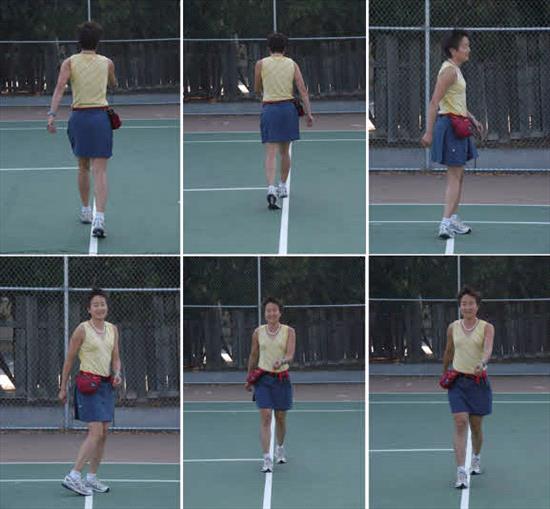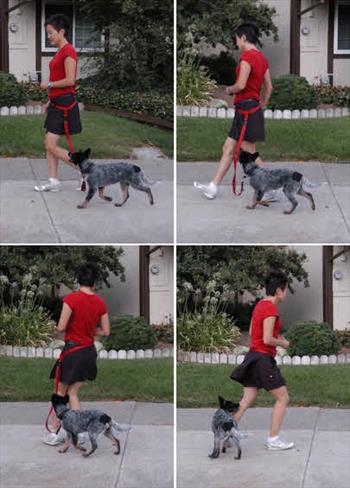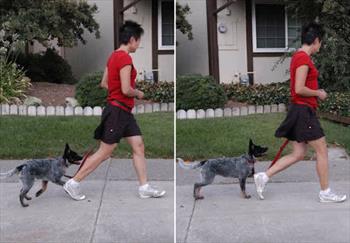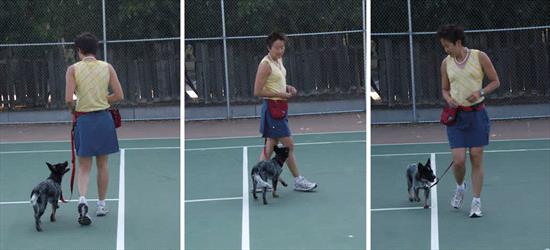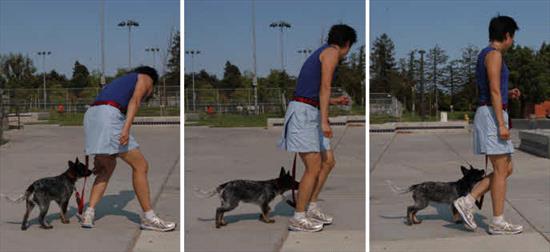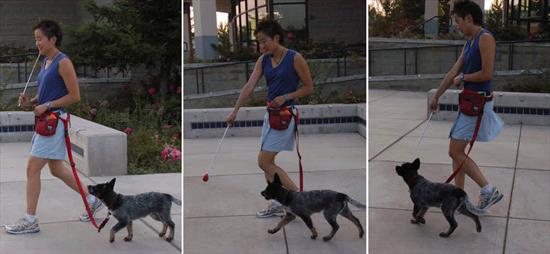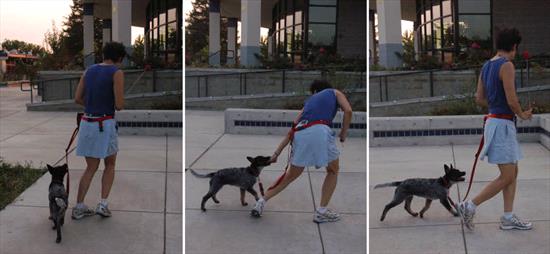Teaching dogs to walk on loose leash is all about:
- Rewarding with treats (bits of Fido’s meal) for heeling next to you and also rewarding Fido by walking quickly enough (at least 120 beats per minute [bpm] using a metronome or 2 steps a second) to make the walk engaging.
- Stopping as soon as Fido’s front paws get ahead of your feet so that you’re stationary by the time he gets to the end of the leash.
- Then increasing the length of time your dog must heel at attention in order to earn rewards until walking nicely becomes a habit and treats are no longer needed.
In addition to these important basics, it’s also handy to have other methods for keeping Fido by your side so that you can vary methods you use, thus spicing up the walk.
In this blog, I’ll introduce the about-turn which you can use: (1) if your dog gets ahead of you, (2) before she has a chance to get ahead of you, or (3) intermittently just to spice up the walk.
First you need to practice without your dog.
As shown in the photos below, in the about-turn, you walk down the line, do a 180° turn with your dog taking the turn on the outside of you, and then you head back up the same line.
This sounds super simple for anyone who walks normally, but when you go to do it with your dog, you’ll tend to walk in ways that confuse him. The key points are:
- You must maintain your regular brisk tempo so your dog knows you’re leading him somewhere.
- You need to walk up and down the same line because if you make a wide arcing turn, to your dog it will seem like you haven’t decided what direction you want to take. If you doubt this, just try leading a blindfolded friend!
- As you are turning you must turn in place but keep your feet stepping in place at that same tempo with which you walked down the line.
Note that if your dog heels on your left side, he will remain on your left side the entire time. Practice without your dog until you feel comfortable and no longer have to think about what you are doing.
Now try with your dog, as shown in the photos below.
Here I walk my Dad’s dog, Lucy. When I do my about-turn, Lucy remains on my left side.
I frequently like to jog for 3 steps out of the turn so that the dog thinks it’s playtime and runs to catch up to me. That increased pace also helps her understand that I’m moving in a new direction. When she catches up, I reward her with a treat. Once she knows this about-turn well, I only have to reward her with treats intermittently.
Note that when I’m walking with Lucy, my arms are bent 90°. I will only straighten my arm when I deliver the treat. This makes a clear distinction between when I mean to give her a treat and when I do not.
What to do if your pooch cuts corners? Dogs commonly cut corners when you start to do the about-turn. That is, rather than staying on your left side, they take a short cut and start walking on your right.
Here Lucy switches in photo 2 from walking on my left side to cutting over to my right side. She is following the law of economics and taking the shortest route! She can stay with me more easily if she cuts sides, whereas if she stays on my left she has to increase her speed and take more steps to keep up with me.
Here are two ways to prevent this cutting.
Solution 1: Lure her with a treat to get her a little bit ahead of you right before you start your turn.
Notice that I start with my arms bent 90 degrees and then when I want to lure her I straighten my left arm and place the treat down to her nose level. She leaps forward to get to the treat as I start my turn.
Once she’s committed to the turn, I give her the treat as I continue to walk. Note that my feet and body keep moving so that I help her continue her momentum around the turn. Once you’ve done this successfully several times, try it without luring.
Solution 2: Targeting to your hand or a target.
This is similar to the luring except that the dog speeds up to touch her nose to a target.
I place the target ahead of me so she gets out in front as I’m about to make the about-turn.
Once she’s touched the target and is committed to the turn, I reward her with a treat and keep walking. It’s important to keep walking so that your momentum guides her to follow your direction of travel. Once you’ve done this several times, try it without the target.
Now that you have this technique down, alternate between doing about-turns and stopping and waiting your pooch out when she gets ahead and is about to pull. Remember to keep an adequate speed before, during and after the turn and to keep walking while you’re giving the treat.
Also randomly add the about-turns during your walk.
Stay tuned for the next blog when you’ll learn how to add U-turns in during your walk.


